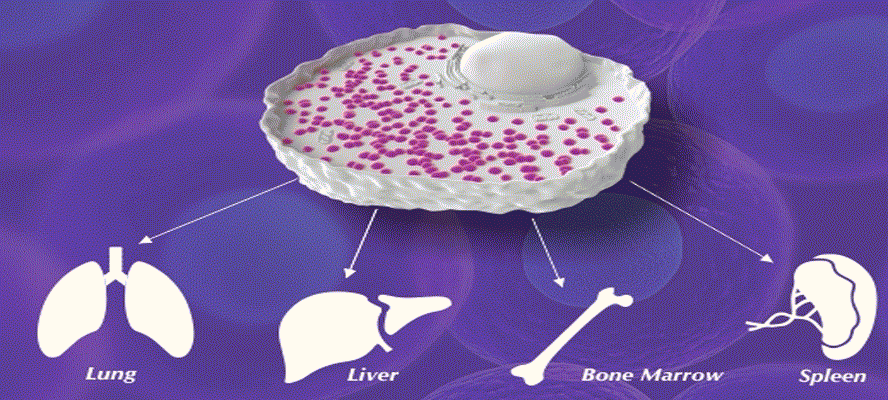Gaucher Disease A Defect In Suicide Cells Hampering Bodys Metabolism
Posted By HealthcareOnTime
Posted on 2022-02-09
All our body cells have morphologically diverse sac-like structures, Lysosomes, with a primary goal to
breakdown or literally degrade any biological polymer, be it proteins, lipids, nucleic acids, carbohydrates,
excess or obsolete cell organelles, food particles, and engulfed viruses or bacteria- all, digested using an
array of specific hydrolytic enzymes! Mutation in the genes encoding for these lysosomal enzymes or defects
in any non-lysosomal activities involved in lysosomal biogenesis or protein maturation cause lysosomal storage
diseases. These defects or deficiencies of even a single lysosomal enzyme cause intra-lysosomal accumulation of
complex biomolecules taken up by the cell or worn out intracellular components, in the affected individuals.
Out of the approximately 50 known lysosomal storage diseases, the most common among these inborn errors of
metabolism, is Gaucher's disease (GD) which affects 1:57,000 to 1:75,000 births worldwide, and is more prevalent
with cases of 1:800 births in individuals of Ashkenazi Jewish descent. India, however has rarity of cases on Gaucher's disease,
with only significant incident being the series of seven cases from Kerala's Malabar area showing increased Gaucher's disease
incidence in a tribe of Mappila Muslims.
"GD-Go-Shey Disease" - Knowing the basics!
Gaucher's disease is an autosomal inherited recessive disease resulting upon mutation in the structural enzyme encoding housekeeping
gene, GBA1 located on chromosome 21, thus causing a defective or reduced stability and catalytic activity of
glucocerebrosidase (enzyme B-glucosidase), lessening the enzyme flux through cells.
Diagnosis of Gaucher Disease
Enzyme activity studies:
The Gold standard test for diagnosis of all variants of Gaucher's disease is detection of insufficient/reduced B-glucosidase
activity in the affected individual, mostly in the peripheral leukocytes. This enzyme activity varies according
to the cell type, decreasing from monocytes to lymphocytes to granulocytes and can also be estimated in cultured
skin fibroblasts or other nucleated cells.
However, its difficult to distinguish between individuals affected with Type 2 and 3 of Gaucher's disease as both show a
reduced B-glucosidase activity. This activity shows overlap in heterozygote carriers and normal indi-viduals.
Thus enzyme analysis alone cannot be used to distinguish carriers from noncarriers.
Mutation analysis: An efficient method for classifying patients and diagnosing carriers by
detecting any common mutations or sporadic and uncommon alleles in various affected ethnic groups.
Genotype testing:
In case the targeted mutation analysis fails to detect both mutant alleles in a patient with deficient
B-glucosidase activity, DNA sequencing of the entire GBA coding region is clinically performed.
Prenatal diagnosis:
If a genetic risk factor is found, prenatal diagnosis is preformed wherein the fetal cells obtained from
chorionic villus sampling or amniocentesis are analysed for the defective enzyme.
Biochemical Tests:
Abnormally high levels of alkaline phosphatase, immunoglobulins levels and angiotensin-converting enzyme or
a cell analysis with glycolipid-laden cells showing crumbled paper cytoplasm are also used to for Gaucher's disease diagnosis.
Gaucher Disease is Treatable but not curable!
Gaucher's disease can't be cured once and for all, but its symptoms can be prevented from worsening and patient's quality of
life can be improved by variety of therapies like splenectomy and bone marrow transplantation. For most Type-1
and Type-2 affected, enzyme replacement therapies (ERT) with intravenous recombinant on mannose-terminated
B-glucosidase are administered.
This decreases abnormal liver and spleen size, reduces skeletal anomalies and regresses many visceral manifestations.
The drawbacks of ERT are its high cost and the resultant immune mediated hypersensitivity. For patients who can't
afford the cost of ERT, substrate reduction therapy is provided which decreases Bglucosidase synthesis. Other
medications are prescribed to reduce the hepatic and splenic sizes and increase the platelet counts in the
affected. Other treatment modalities under research include pharmacological chaperone which can modify in
situ the endogenous dysfunctional/mutant enzyme by interacting with specific agents to improve lysosomal
activity
Gaucher's disease patients are at
a high risk of Parkinson's disease
due to defective cellular waste
removal and accumulation of
dysfunctional mitochondrial cells.
Managing Gaucher Disease
Since its a genetic defect and can't be prevented, the foremost requirement for affected individuals is
a strong emotional support, positive outlook and social relationships from their close ones. Treatment
of any form of Gaucher's disease is not quite affordable for a common man even if other treatment modalities are available
to prolong the longevity of a patient as GD's rarity made governments to inhibit investments on its further
research or large scale trials for optimum doses and schedules. An individual's financial burden and faltering
emotional support can surely make living with Gaucher's disease a difficulty, as Gaucher's disease doesn't manifest with a single treatable
symptom but attacks with multi-organ involvement including visceromegaly and neurodegeneration. Improvement
of the staging systems, development of dosing schedules, treatment goals are essential for proper management
of the affected and improving their quality of life.
Contrary to size, extremely populous India being the land of consanguineous marriages, unavailability of exact
prevalence studies in the population doesn't make Gaucher's disease an uncommon occurrence. Lack of awareness among the rural
and even urban families definitely is a major drawback to even find out the approximate prevalence of Gaucher's disease. The
need to create awareness among the populace as well as the medical community to foster accurate diagnosis and
proper management of patients is mandatory. Appropriate genetic counselling and prenatal diagnosis of Indian
families can surely help the already affected with this lifelong disease, to cope up and also, reduce the
impe-nding risk on the future progeny of a family. Gaucher's disease is now not unheard of, and gene therapies and gene
vaccines are the future targets for curing this malicious, hereditary multi-organ ailment!
Gaucher's disease is
Not preventable, incurable
as its inheritable. Management
is the only way to prolong the inevitable!





















































